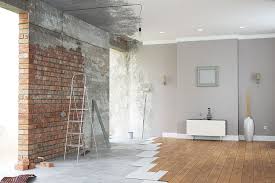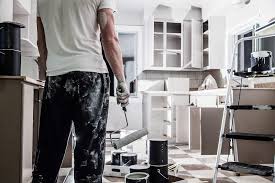Do I Need Permits for Home Renovation?
Especially if you are not building onto the existing boundaries of your home, such as building a room addition, you might think that you do not need to apply for a permit before you get started. The short answer is that, yes, you do need a permit or sometimes multiple permits for a home renovation
What Happens If You Do Not Get a Building Permit?
It is not unusual for homeowners to proceed with house renovation projects, especially smaller ones, without getting a permit. You might even know friends and neighbours who have done this. The fact is, these people are breaking the law and could be penalized for this.
Even Small Jobs Often Require a Permit
As mentioned, it is not just larger major construction projects that require a permit. Even smaller projects that are not detectable form the exterior of the house may require a building permit to proceed. This can include finishing a basement, adding a new bathroom, or updated electrical or plumbing systems.
Why Are Building Permits Necessary?
While these regulations may seem like an unnecessary hassle, but many of these requirements exist for your safety and the safety of anyone in or near your building. If your new electrical system is not approved, it is likely because it poses a fire hazard. It is for your own benefit to complete your home remodel to code. If you are not sure whether or not your building plans and practices will meet all of the necessary standards, it is wise to have a licensed and experienced contractor assist you with the project.
Have a Professional Help You Meet All Building Requirements
If determining which permit or permits you need for your renovation project, and then following all of the necessary steps, sounds like a nightmare to you, hire a contractor that will help you with this process. By doing so, you receive the support of a professional who has completed numerous projects in your area in the past and knows exactly which permits you need and how to get them.

Can I live in the House During the Home Renovation Process?
While the idea of a renovated home is very exciting, many families are afraid of the possibility of being displaced from their home while the project is completed.
Scope of the Project
If you are doing a whole-house renovation or another major construction project, it is unlikely that staying in the home will be feasible. The home will not be inhabitable if exterior walls are being torn down, the roof is removed to add a second floor, or other invasive changes are taking place. Aside from the obvious reasons that this would not be an enjoyable setting for a family, the construction process would also be dangerous.
Access to Kitchen and Bathrooms
Even if there is only one room being renovated, if this room is your kitchen or only restroom, you should make other living arrangements. You might think you can do without the kitchen for a short period of time, but this can become very disruptive to your routine if you have children.
How Will You Staying In the House Affect the Schedule and Budget?
Some Homeowners decide to stay in their houses during a home renovation to avoid the cost of staying in a hotel or paying for other accommodations. Choosing to stay in the house, however, can actually make the construction process take much longer, which adds to the cost.
When You Can Definitely Stay In Your Home
There are house renovations that can be finished while you stay in the home. If your renovation project only affects a small, isolated area of the house and will not require the utilities to be turned off for extended periods of time, you can stay in your home during the renovation. Common examples of these projects may include a finishing a basement or adding a room addition.
Are there any home renovation tax credit options?
Are you thinking about making any renovations to your home? Or have you done so in the past couple of years? you may be eligible for a home renovation tax credit or housing rebate – especially if you are 65 or older. This is part of the government’s effort to increase the number of healthy, environmentally friendly homes. Regardless of your income, you and your family might qualify for a tax credit or rebate.
Healthy Homes Renovation Tax Credit
This is a permanent personal income tax credit for seniors over the age of 65 and the relatives who live with them. Those who qualify can claim up to $10,000 worth of certain home improvements on tax returns. The amount of credit you could get back is calculated as 15% of the eligible expenses claimed.
What home improvements qualify?
Not all home renovation works qualify for this tax credit. Examples of work that DOES qualify include:
Wheel-in shower installation
Walk-in bathtub installation
Lowering of existing cupboards and counters
Renovations that allow for a first-floor occupancy for a senior
Widening of doors
Handrails
Grab bars in the bathroom, near the tub and toilet
Non-slip flooring
Wheelchair ramps and stair lifts or elevators
Easy to use door locks
Motion-activated lighting
Touch-and-release cupboards and doors
How do you get the credit?
Schedule ON (S12) must be completed on your tax return. The amount you spent on the eligible renovations should be entered on form ON (479) next to box 6311. Even if a relative or friend did the renovation work free of charge, you can still claim the amount you spent for the modification and materials.
Goods and Services Tax – Harmonized Sales Tax Rebate
The GST/HST offers housing rebates for individuals who have purchased a new home, substantially renovated their home, leased land for residential rentals, etc. For eligibility, the substantial renovation must include major changes. In general, 90% or more of the interior of the existing home has to be replaced or removed. Supporting walls, floors, roof, staircases, and the foundation do not have to be replaced or removed. The substantial renovation only includes livable areas. Finished basements and attics apply; crawl spaces and garages do not.

A Guide to Siding Options for Exterior House Renovations
Don’t neglect the outside of your home when doing renovations. It doesn’t matter how nice the inside looks, nobody is going to feel welcomed if the exterior is lacking – not to mention the trouble you’ll have selling your home someday if it doesn’t have nice curb appeal. The siding is one of the most important elements of exterior house renovations. There are a number of materials to choose from, depending on your budget and preferences.
Siding and Materials
Vinyl siding is relatively new to homes. It’s a lightweight material that is easy to handle. As such, it is often used for retrofitting. Expanded polystyrene foam is sometimes found insulated on vinyl siding, providing a value of R2 to R6 insulation. Insulated vinyl costs a bit more than non-insulated vinyl. The downside to vinyl siding is that there may be noticeable seams, since the panels must be overlapped at times.
Stucco siding is extremely durable and goes well with other materials. Epoxy is found in contemporary stucco mixtures to prevent cracking and chipping. When stucco is taken care of, it will last a lifetime. Additional benefits include fire resistant, insect resistant, permanent colouring (when toners are added), and low-maintenance.
Wood is always a great choice for traditional homes. Since it’s available in numerous species and grades, you’ll need to consult with your designer to determine what type of design to go with. Less-expensive grades are ideal if you want to use paint or opaque stains. For a natural look, go with a grade that is free of blemishes and knots. Cover it with a semi-transparent stain or clear sealer.
Synthetic stone is not always used to cover an entire house. Instead, it’s often used as an accent to cover chimney exteriors or lower portions of walls. Thanks to modern manufacturing techniques, the final product looks as natural and realistic as possible. Any type of stone can be mimicked, from limestone to river rock. The mixture may include sand, cement, concrete, etc. The downside to synthetic stone is that it is on the expensive side compared to other siding options.
Brick siding is a very classy, yet expensive option for a home. It’s typically found on Tudor, Colonial, and English-style cottage exteriors, providing a look that has been around for centuries. When installed correctly, brick siding can last for the lifespan of the house. Modern brick siding is a veneer constructed outside of a house’s wood frame structure. Mortar is used to hold each brick in place.
Fiber-cement siding is made from a mixture of cement, wood pulp, sand, and clay, and it offers the look of stucco or masonry at a cheaper price. It’s a low-maintenance and termite-resistant choice. There are many textures, styles, and finishes available. It easily accepts paint, or, if you prefer, comes in a factory-applied finish. A potential downside is that retrofitting requires that the old siding be completely removed which can be costly.
Your complete beginner’s guide to renovating a house
Isn’t it great that you don’t have to buy heaps and heaps of building materials to build a house from scratch? You can simply take an old existing one, splash a new coat of paint on it, replace the ‘welcome’ mat, and move in!
Actually renovating an old property involves a bit (okay, a lot) more work, yet for those who love a challenge, it is the best way to either find their dream home, or spruce up an outdated structure so that others might find their dream home.
Find and assess your project
Almost every property has some potential for renovation – the secret is to assess its design- and financial potential before committing to a full-on renovation.
Chat with agents, drive around yourself to scope out potential projects, and attend auctions. Once you’ve found a project, an assessment of the structural condition of the house is important, and that is where a professional surveyor steps in. Be sure to arm yourself with a checklist of the most common problems found in old properties (such as rewiring, cracks, no heating, etc.).
Completing the deal
There are several options available here for renovators. If the property you wish to renovate is habitable, then you can go straight to one of the usual high street lenders. If you do not have the funds available to pay for the building work required on the house, you might consider a loan, which will hopefully be repaid by remortgaging the completed property.